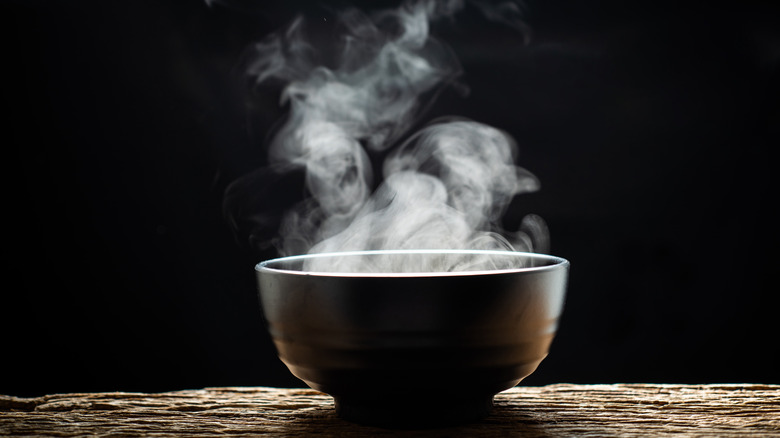What 'Soup Mother' Really Means
The concept of a "mother" within a culinary context is usually reserved for sourdough starters or apple cider vinegar — but did you know that it can also be applied to soup? After setting Instagram ablaze with the concept, pastry chef Natasha Pickowicz spoke with Grub Street and detailed her method for the age-old concept.
Initially, Pickowicz posted an Instagram story inquiring if any of her followers also had a "mother soup," which she noted as something that "she had been continuously cooking and feeding with new ingredients." Her original "soup mother" IG story defines a soup mother process as such: "I eat all my soup except for 10% and then use that base to build the next soup and the next soup and the next soup. Deepest richest flavor." There's a simplicity to this approach that clearly resonated with her followers. Besides, saving time, money, and enjoying a rich, deeply flavored meal that celebrates prior culinary success? It's like the culinary equivalent of the Russian nesting doll.
While this isn't an entirely novel idea — Pickowicz notes that she is not the originator — it's certainly not the most commonplace means of soup making. In her conversation with Grub Street, Pickowicz stated, "I think we need to understand the idea of one concentrated thing beginning the next, new thing, even if this is a little different because it's cooked." Pickowicz notes on Instagram that her soups "evolve over time."
What is the theory behind the soup mother?
"We're so stuck in the recipes ... that you forget that cooing can be this super intuitive, relaxing process that doesn't have edges around it, but is this ambiguous thing that flows into the next thing," Natasha Pickowicz shares with Grub Street. Pickowicz acknowledges the finite nature of ordering out or cooking just enough servings for those planning on eating — you cook, you eat, the food is gone. But why not "open up" that idea, repurposing leftovers, making the most out of ingredients and coaxing out as much flavor as possible from dishes throughout? On Instagram, Pickowicz elaborated on this point, exploring the "intersection of intuition and thrift and laziness in home cooking" and how she's "always pursuing the idea that one meal can flow into the next, building flavor but also feelings and memories, instead of fixing hermetically sealed little meals that make 1-2 portions."
She notes that it makes her feel good "on an emotional level," knowing that the "soup mother ... is bubbling all day [and filling] my home with a wonderful smell that I feel connected to." Pickowicz states that while she "thought of it as a Chinese thing," the concept is not regionally or culturally specifically, with Instagram commenters saying that her stews and soups echo a bit of the flavors and approach of Mexican and Polish soups.
How is the soup mother made?
Natasha Pickowicz's general base consists of water, Kombu, celery, carrots, onion, fennel, bay or oregano, mushrooms, olive oil, garlic, pepper — this is then reconstituted, reheated, or poured over other leftovers. She also replied to a follower that she keeps her "mother soup" right on the stove with the lid on, but it gets refrigerated if she's not working with or repurposing it within a few days. She also mentions how the flavors and textures differ from day to day, specifically noting that it is "nice to have multiple days of carrot in one bowl to compare the softer and firmer textures." In addition, adding more ingredients to that base will only strengthen the flavors and deepen the complexity. She notes to be mindful not to add starch to the original "mother," because most starches such as beans, chickpeas, and rice, will get soggy if or when you're repurposing the base.
Her tip for those that are a bit squeamish? "Try freezing 1 cup of the next delicious thing you make and then stir into your next delicious thing," Pickowicz states on her Instagram. If you're in the mood for hearty, comforting soup, try out Chef Natasha's method, embracing the restorative nature of a soup and flavor that has been built and fostered over the course of a few days.


